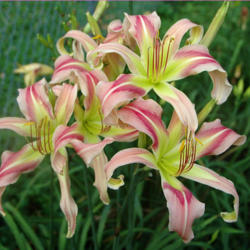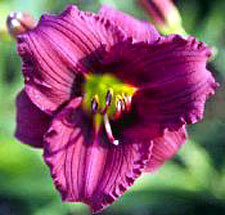
Gardeners can't get enough of daylilies, and it's easy to understand why. Other flowers may be as beautiful, but no other plants are as rugged, widely adapted, or versatile. Daylilies are gorgeous, and they are survivors--perfect plants for both the connoisseur and the weekend warrior.
The PlantOriginally from Asia, daylilies have adapted to the challenging and varied climates of the United States with all the vigor of its best native plants. They grow in all U.S. regions, but thrive in USDA Hardiness Zones 4 through 9. Daylilies have arching, straplike foliage. Flowers are borne on tall stems, called scapes, that rise above the foliage. They are available in a range of sizes; some varieties grow just 12 inches tall; others reach 3 feet. (Note that the height given in plant descriptions usually refers to the height of the flowers; the foliage may be significantly shorter.)
The FlowersTrue to its name, each daylily flower remains open for only one day, but each flowering scape contains numerous buds. The color range of daylilies has expanded to include everything but blue and pure white. Many blossoms are bi- or tri-colored, and some have striking "eyes"--zones of different colors surrounding the throat. Single daylilies have six petals, while double varieties have a second set of petals, often ruffled. In the Far East, daylily flowers are used in recipes and can be eaten raw or cooked. They are often found as a dried food in stores.
How to Use DayliliesDaylilies are stalwarts of the perennial border, but they shine in other spots, too. Vigorous daylilies grow thickly enough to choke out most weeds, making them a low maintenance ground cover. They excel at holding the soil on steep slopes and other erosion-prone spots. Plant them on banks and roadsides or along waterways. Use dwarf daylilies in rock gardens, in containers, or as edging for flower beds. When planting several daylily varieties, arrange them in drifts of a single variety for a natural look.

Daylilies grow best in full sun, ideally 6 hours or more daily. However, in hot and dry climates, they benefit from some afternoon shade, as well as irrigation during bloom. Also, many of the deep reds and the paler shades hold their colors better in partial shade. In any zone, daylilies will perform reasonably well with half a day's shade--they just won't bloom as vigorously.
Daylilies grow well in a wide range of soils. You can plant them successfully almost any time the ground can be worked. To plant bareroot daylilies, work the soil to a depth of 12 inches. Dig a hole, then make a mound of soil in the center. Set the plant on the mound with the crown at the soil surface or no more than an inch below. Firm the soil around the roots, and water well. Space plants 18 to 24 inches apart.
The ideal time to transplant or divide your planting is in spring as the shoots begin to emerge, or immediately after bloom. When replanting, set the plants at the same height they grew at previously or slightly higher to allow for settling. Firm the soil, then water. Some cultivars can grow for 20 years without requiring division, but others may need division every second or third season. You'll know it's time to divide when flower production beings to decline.